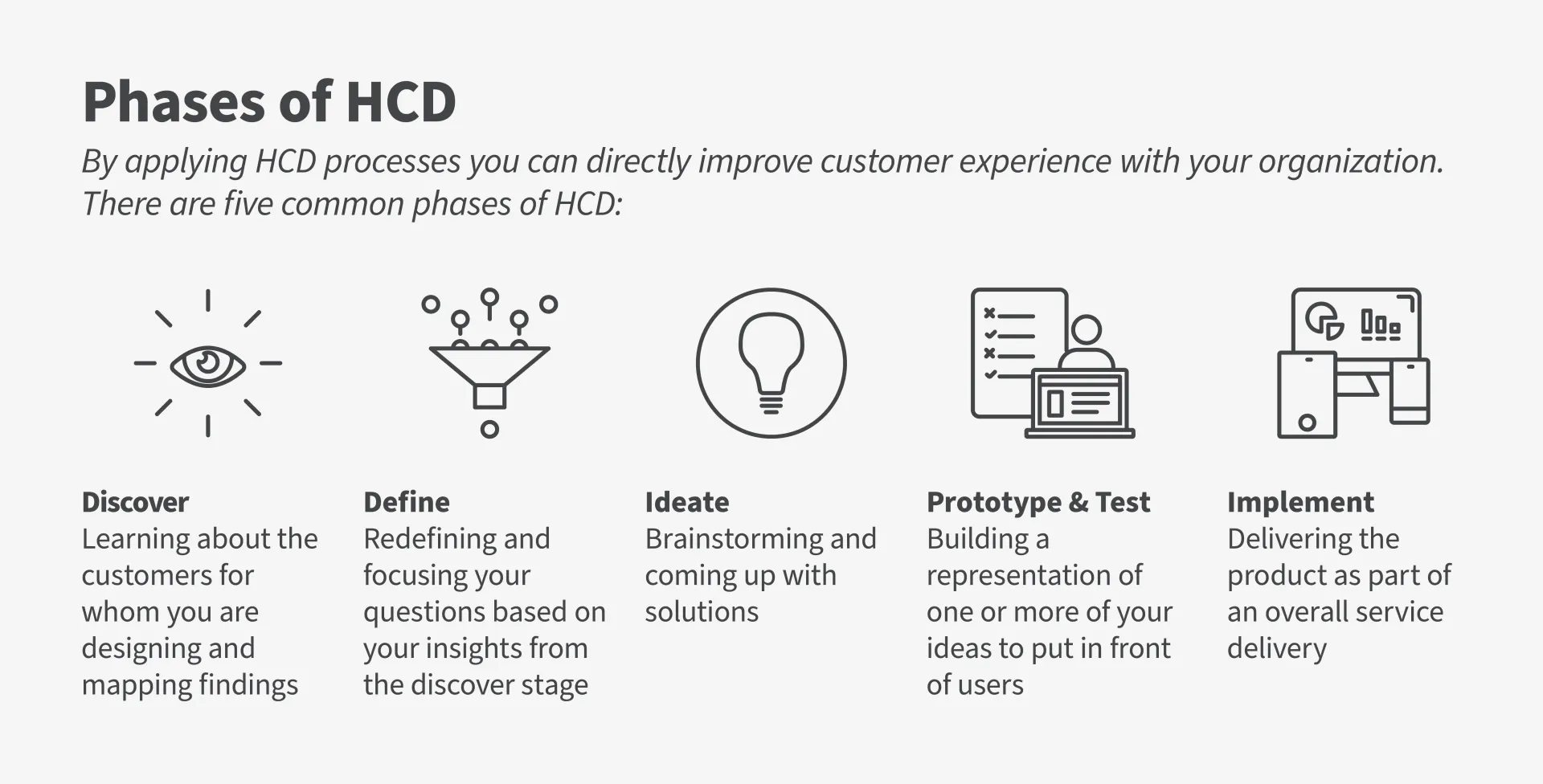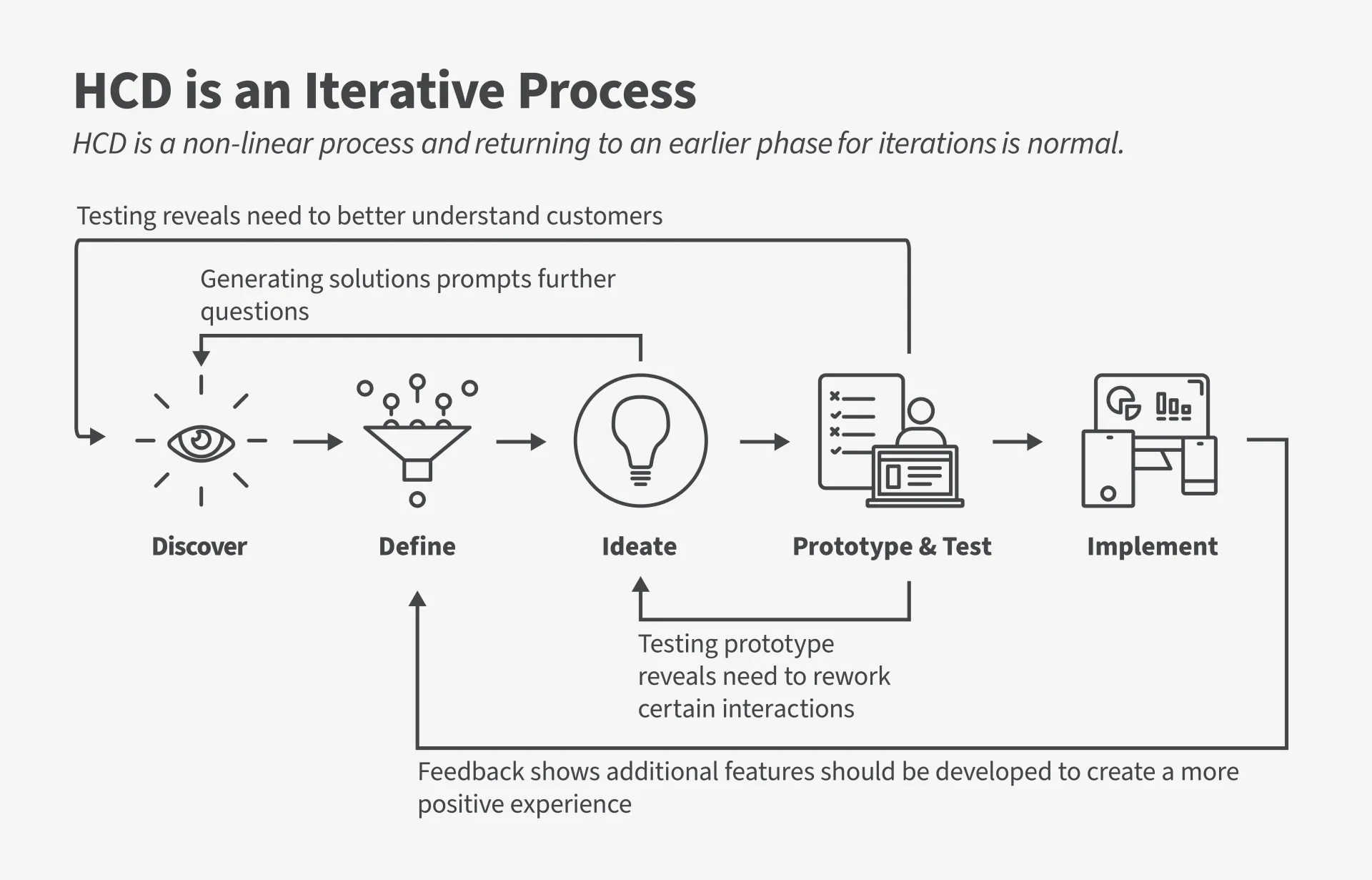Intro to CX Lesson | 20 Minutes
Learning Objectives
- Understand what human-centered design is
- Understand the ‘discover’ phase of human-centered design
- Understand the ‘define’ phase of human-centered design
- Understand the ‘ideate’ phase of human-centered design
- Understand the ‘prototype & test’ phase of human-centered design
- Understand the ‘implement’ phase of human-centered design
- Understand that human-centered design is an iterative process
DHS takes a customer-centric approach to better understand the people we serve and to create services and products that meet their needs.
By using human-centered design (HCD) processes, DHS is creating more effective and efficient services and products for its customers.
So, what is human-centered design?
Human-Centered Design
Human-centered design is a problem-solving framework that brings together the ideas and expectations of organizations and their customers to create services and products that are more effective and efficient in serving their customers' needs.
HCD consists of five common phases:
- Discover (empathy, research & mapping)
- Define
- Ideate
- Prototype & Test
- Implement
These five phases act as guideposts and should be followed at the outset of your service design to ensure your services and products will meet the customers’ needs. As you progress through each phase you may find yourself repeating specific phases or circling back to a certain phase as part of the iterative process.
Discover Phase
Definition: Learning about the customers you are designing for and mapping their experience relative to your service/products.
In this phase, you work to understand your customers’ environment and identify their goals, tasks, activities, motivations, patterns of behavior, and the positive and negative interactions they experience through their journey with your organization. This information comes together to help you understand and create services/products that truly meet your customers' needs.
Example: The Federal Emergency Management Agency (FEMA) sends employees to a natural disaster site to conduct interviews as a form of user research. Interviews are conducted with those who have been directly affected by the natural disaster to understand their situation, how they are currently being assisted, and how FEMA could better support their needs. By conducting user interviews, FEMA gains a better and deeper understanding of their customers' experience.
Define Phase
Definition: Defining your customers’ challenges and creating questions to drive service improvements based on your insights from the ‘discover’ phase.
By collecting and analyzing your data from the ‘discover’ phase, you can begin organizing and synthesizing data, information, and ideas to update features, functions, and/or create additional services/products to address the pain points your customers faced during their experience with your organization. During the ‘define’ phase, you will test your initial beliefs, develop a deeper understanding of workflows and processes, and develop questions to answer as you consider iterations to the design of your service/product.
Example: Citizenship and Immigration Services (USCIS) analyzes the qualitative and quantitative data they collected during the ‘discover’ phase to create customer personas and journey maps that help identify and define their customers’ challenges. USCIS uses personas to represent customers that are applying for U.S. citizenship to help establish their voice (VoC), which is a true reflection of their experience, and to better understand the challenges they face as they apply for citizenship. In addition, USCIS uses journey maps to better understand each positive and negative touchpoint along a customers’ journey as they apply for U.S. citizenship. Mapping each touchpoint helps USCIS service teams better identify areas for improvement in their service delivery to address their customers’ needs.
Ideate Phase
Definition: Brainstorming and generating concepts based on data from the ‘discover’ phase.
This phase focuses on gathering and planning solutions to the challenges your customers encounter with your service/product.
Example: The Cybersecurity and Infrastructure Security Agency (CISA) uses a whiteboard, digital or physical, to brainstorm and map out ideas for solutions to an email phishing threat that is targeting government employees. CISA employees collaborate to come up with potential firewall solutions that they will later build prototypes for and test.
Prototype & Test Phase
Definition: Building a representation of one or more of your ideas to put in front of users.
You may build and test multiple prototypes, physical and/or digital, in your search to craft solutions to your customers’ pain points. You may test a prototype that works and schedule it for implementation or revert to the ‘ideate’ phase if your prototype does not meet the needs of your customers. Or, you may find that parts of your prototype work well to solve customer’s problems, but other parts don’t. In that case, using data from observing and listening to customers in sessions where you are proving out concepts or conducting usability testing, your team would iterate to remedy issues and improve the service or product.
Example: The Coast Guard (USCG) creates a digital mockup based on their initial brainstorming session for a new safety floatation device that would enhance their ability to aid any individuals struggling to stay afloat at sea. After their mockup gains approval from USCG leadership, the design team can create a physical prototype of the safety floatation device. After building the prototype, it needs to be tested. USCG would recruit participants for usability testing to gain user feedback that is used to inform any iterations that may be required to ensure it meets the users’ needs.
Implement Phase
Definition: Delivering the service/product.
Releasing and updated service/product and monitoring it by obtaining customer feedback to measure its effectiveness in serving your customers' needs.
Example: Immigration and Customs Enforcement (ICE) will validate a new training program for their employees by collecting feedback from those participating in the training to ensure that the program is working as intended. ICE examines the error/success rates of their trainees to either validate their new training program or seek further iterations based on their collected participant feedback. Collecting feedback is an ongoing process that ensures the training program stays effective throughout its use.
Human-Centered Design is an Iterative Process
Reminder: HCD is a non-linear process and returning to an earlier phase for iterations is normal.
Some reasons you may want to return to earlier phases of the process are:
- Testing reveals need to better understand customers.
- Generating solutions prompts further questions.
- Testing prototype reveals need to rework certain interactions.
- Feedback shows additional features should be developed to create a more positive experience.
In Summary
Applying the human-centered design framework is an essential part of improving customer experience. Bringing a customer-centric approach to your service delivery helps your organization create a better experience for your customers by identifying any challenges they have encountered and providing solutions to meet their needs.
By applying the HCD framework, DHS is providing its customers with essential, relevant, and easy to use, customer-centric solutions that increase the public’s trust and confidence in our service delivery.
Resources
Article:
Why We Need UX Researchers & Designers P1 (DHS CX)
Why We Need UX Researchers & Designers P2 (DHS CX)
Web Resource:
Creating a User-Centered Approach (Usability.gov)
Download:
Human Centered Design Discovery Field Guide (Performance.gov)
Video:
Simplifying user experiences for complex content at USAGov (Digital.gov)



